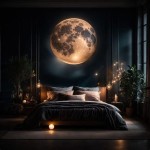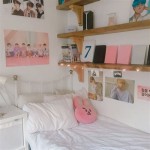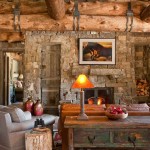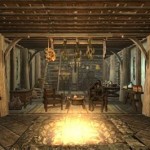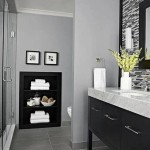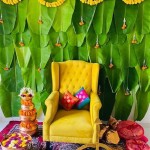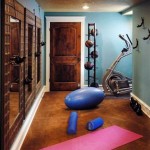Boho Decor: A Comprehensive Definition
Boho decor, short for bohemian decor, embodies a style characterized by its eclectic, free-spirited, and unconventional nature. Rooted in the bohemian lifestyle of the 19th century, which emphasized art, literature, and intellectual pursuits over traditional societal norms, boho decor prioritizes self-expression and a rejection of rigid decor guidelines. It celebrates individuality and embraces a sense of global exploration, resulting in spaces that are both visually stimulating and deeply personal.
Unlike minimalist or modern aesthetics that often prioritize clean lines and uniformity, boho decor is intentionally layered and seemingly haphazard, although careful consideration is given to the overall harmony of the space. It's about creating an environment that feels lived-in, comfortable, and reflective of the inhabitants' personalities and experiences. This aesthetic is often associated with artists, writers, and travelers, individuals who value experience and creativity above material possessions.
The core of boho decor lies in its ability to blend different styles, textures, and patterns seamlessly. There's an inherent sense of history and storytelling within boho spaces, often achieved through the incorporation of vintage finds, handcrafted items, and souvenirs collected from travels. The result is a unique, layered aesthetic that defies easy categorization and evolves organically over time.
Key Elements of Boho Decor: Texture and Textiles
One of the most defining characteristics of boho decor is its emphasis on texture and textiles. These elements contribute significantly to the overall warmth and visual interest of the space. Natural materials such as cotton, linen, jute, and wool are prevalent, often found in rugs, curtains, cushions, and throws. Layering different textures creates depth and dimension, making the space feel inviting and tactile.
Textiles often feature intricate patterns and vibrant colors, drawing inspiration from various cultures and traditions. Ikat prints, kilim designs, Moroccan rugs, and hand-embroidered cushions are common choices. These patterns can be mixed and matched freely, creating a sense of visual richness and eclecticism. The key is to find a balance where the patterns complement each other rather than clash, a skill that often requires a discerning eye and a willingness to experiment.
Beyond patterned fabrics, textured wall hangings, macrame plant holders, and woven baskets add to the overall tactile experience. These items not only serve as decorative elements but also contribute to the bohemian ethos of handcrafted beauty and a connection to nature. The use of fringe, tassels, and embroidery further enhances the textural richness of the space, adding a playful and whimsical touch.
The way textiles are used is also crucial. Draping fabrics over furniture, hanging tapestries on walls, and layering rugs on floors are all common techniques used to create a bohemian atmosphere. The intention is to create an environment that feels relaxed and unstructured, encouraging a sense of ease and comfort.
Key Elements of Boho Decor: Color Palette and Natural Elements
The color palette in boho decor is typically warm and earthy, drawing inspiration from nature and global cultures. Neutral tones such as beige, cream, and brown serve as a foundation, providing a calming backdrop for bolder accents. These neutral hues create a sense of grounding and allow the more vibrant colors and patterns to stand out.
Accent colors often include rich shades of terracotta, rust, ochre, deep blues, emerald greens, and vibrant purples. These colors can be incorporated through textiles, artwork, and decorative accessories. While there are no strict rules regarding color combinations, it's essential to consider the overall balance and harmony of the space. A well-curated boho space often features a mix of warm and cool tones, creating a visually engaging and stimulating environment.
The incorporation of natural elements is another defining feature of boho decor. Plants play a vital role, bringing life and vibrancy into the space. A variety of plants, from small succulents to large leafy ferns, are commonly used to create a sense of indoor jungle. Hanging plants, potted plants, and even dried flowers contribute to the overall natural aesthetic. The use of natural light is also crucial, allowing the plants and colors to truly shine.
Other natural elements include wood, stone, and metal. These materials are often incorporated through furniture, decor items, and architectural features. Wood furniture with a natural finish, stone accents on walls, and metal light fixtures all contribute to the organic feel of the space. The use of raw or unfinished materials further enhances the connection to nature and adds to the overall bohemian aesthetic.
Key Elements of Boho Decor: Furniture and Accessories
Furniture in boho decor is often a mix of vintage, antique, and contemporary pieces. There's a preference for comfortable and relaxed furniture, such as low-slung sofas, plush armchairs, and floor cushions. These pieces encourage a sense of informal gathering and relaxation. The use of natural materials like rattan, wicker, and wood is common, adding to the overall bohemian aesthetic.
Upholstery often features natural fabrics, such as cotton, linen, and velvet, in a variety of colors and patterns. Layering cushions and throws adds to the comfort and visual interest of the seating area. The inclusion of unique and unconventional furniture pieces, such as vintage trunks used as coffee tables or repurposed ladders used as shelving, further enhances the eclectic feel of the space.
Accessories play a crucial role in completing the boho look. Decorative items such as candles, incense holders, dream catchers, and crystals add to the spiritual and whimsical atmosphere. Artwork often includes abstract paintings, tribal prints, and photographs that reflect the inhabitants' personal interests and experiences. The use of mirrors can help to create a sense of spaciousness and reflect natural light, enhancing the overall ambiance of the room.
Lighting is also an important consideration. Soft, ambient lighting is preferred, creating a warm and inviting atmosphere. String lights, lanterns, and candles are commonly used to create a magical and enchanting ambiance. The use of lamps with unique shades and bases adds to the eclectic and bohemian feel of the space. Overall, the furniture and accessories contribute to a space that is a personal reflection that feels collected and curated over time rather than bought as a set.
Ultimately, boho decor is a celebration of individuality and self-expression. It is a style that embraces imperfections and encourages the creation of spaces that are both visually stimulating and deeply personal. By incorporating key elements such as texture, textiles, natural materials, and a mix of vintage and contemporary furniture, one can create a truly unique and bohemian-inspired home.

Boho Home Decor 10 Genius Interior Design Tips For A Licious Space Skha

Design Trend Defined Boho Chic Confettistyle

Everything You Need To Know About Bohemian Design What Is

10 Ways To Create Your Dream Boho Style Iiad

Boho A Timeless Design Style For Interiors Hommés Studio

10 Ways To Create Your Dream Boho Style Iiad

Boho A Timeless Design Style For Interiors Hommés Studio

What Is The Boho Chic Home Decor Style

What Is Bohemian Design Style

Bohemian Design Style What It Means And How To Get The Look Décor Aid
